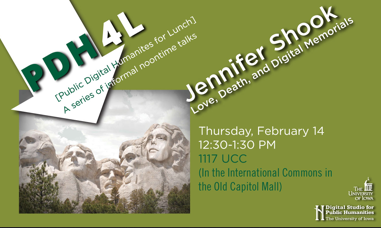Crossposted from my HASTAC blog; you can find my original post here at the HASTAC site.
The University of Iowa’s Digital Studio for Public Humanities‘ lunchtime talk series continued this past Thursday with a thought-provoking journey through some recent trends in the interactions between digital and memorial culture, ably conducted by Jennifer Shook (Dept. of English).
The trip began at Mount Rushmore. The monumental memorials of the eighteenth and nineteenth century are, as Jennifer pointed out, particularly ripe for subversion, parody and other forms of commentary. (As you may be able to see in the image accompanying this post, where one of the US presidents has been replaced with Michael Jackson; a similar image featuring Miss Piggy from the Muppets drew quite the giggle from the audience.) With their monolithic narratives about what it is to be American, and with their often imposing physical presence, they often inspire people to physically “recreate” them, to Photoshop images of them, to create online narratives which rely on people’s pre-existing knowledge of the monuments for their impact.
(This was really fascinating to me inasmuch as now that I reflect on it, I don’t know how much this occurs to the same extent in my home country of
Ireland. We have, of course, a rich tradition of often very dark satire, but perhaps we tend to site that more in words than centring it around physical memorials? And when subversion and mockery happens, it doesn’t tend to centre around the statues of famous Irish people such as Daniel O’Connell or Big Jim Larkin, but on the non-anthropomorphic Spire or the Floozie. Perhaps it’s simply a reflection of the fact that we tend not to build on as grand a scale.)
Most of Jennifer’s talk focused on what’s happening now that this long-standing tradition of memorialising has entered the digital age. She shyed away from using the word “democratising” (rightly, I think, as it’s problematic to think that we now live in an age of a level playing field), but instead emphasised how digital memorials offer more scope for a multiplicity of voices. Many of these projects, like the AIDS Quilt Touch project, take the physical memorial and make it more widely accessible; others, like the Bdote Memory Map, restore new layers of meaning to existing physical memorials which exclude subaltern voices.
I found many of these new digital memorials to be fascinating, particularly in their abilities to alter and grow as more people add their voices to them. The first iteration of the Bdote site, for example, was very different to its current form, and Jennifer’s talk was very celebratory of their activist and inclusive potential. Yet these digital memorials raise as many issues as they address—what about someone who doesn’t wish to be memorialised? Who finds, for instance, the thoughts of being represented to millions of people for decades to come by their elementary school photos to be quite horrifying? What happens when there’s no one left to pay for the annual domain renewal, or when the server crashes and there are no backups?
One of the images Jennifer showed was of a cemetery in England which offers people the ability to have a QR code engraved on their headstone. Any curious passer by can scan this code with their smartphone and be taken to the person’s life story, hosted on the cemetery’s website. For now, QR codes represent an expanding form of technology, and perhaps for the next twenty or thirty years those life stories will be comprehensible and legible to people. But what will happen when technology moves on, when people forget how those blocky symbols were once supposed to function—will we have unwittingly created a digital Linear B?
